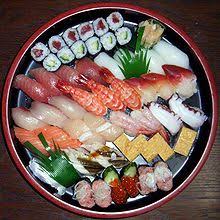I don’t eat sushi.
The combination of rice and raw fish sets off way too many risk buttons for me.
 There was this one time, about eight years ago, I went to Dubai and Abu Dhabi, to evaluate a graduate program and hang out at Dubai’s food safety conference.
There was this one time, about eight years ago, I went to Dubai and Abu Dhabi, to evaluate a graduate program and hang out at Dubai’s food safety conference.
A microbiologist from the University of New South Wales was also enlisted (and knew more about this stuff than I did).
One night, our hosts took us to dinner featuring a buffet overflowing with raw seafood.
He said, “Don’t.”
You don’t want to know the microbiological profile of that raw seafood, or something like that.
The University of Washington says, the next time you eat sashimi, nigiri or other forms of raw fish, consider doing a quick check for worms.
A new study led by the University of Washington finds dramatic increases in the abundance of a worm that can be transmitted to humans who eat raw or undercooked seafood. Its 283-fold increase in abundance since the 1970s could have implications for the health of humans and marine mammals, which both can inadvertently eat the worm.
Thousands of papers have looked at the abundance of this parasitic worm, known as Anisakis or “herring worm,” in particular places and at particular times. But this is the first study to combine the results of those papers to investigate how the global abundance of these worms has changed through time. The findings were published March 19 in the journal Global Change Biology.
“This study harnesses the power of many studies together to show a global picture of change over a nearly four-decade period,” said corresponding author Chelsea Wood, an assistant professor in the UW School of Aquatic and Fishery Sciences. “It’s interesting because it shows how risks to both humans and marine mammals are changing over time. That’s important to know from a public health standpoint, and for understanding what’s going on with marine mammal populations that aren’t thriving.”
Despite their name, herring worms can be found in a variety of marine fish and squid species. When people eat live herring worms, the parasite can invade the intestinal wall and cause symptoms that mimic those of food poisoning, such as nausea, vomiting and diarrhea. In most cases, the worm dies after a few days and the symptoms disappear. This disease, called anisakiasis or anisakidosis, is rarely diagnosed because most people assume they merely suffered a bad case of food poisoning, Wood explained.
 After the worms hatch in the ocean, they first infect small crustaceans, such as bottom-dwelling shrimp or copepods. When small fish eat the infected crustaceans, the worms then transfer to their bodies, and this continues as larger fish eat smaller infected fish.
After the worms hatch in the ocean, they first infect small crustaceans, such as bottom-dwelling shrimp or copepods. When small fish eat the infected crustaceans, the worms then transfer to their bodies, and this continues as larger fish eat smaller infected fish.
Humans and marine mammals become infected when they eat a fish that contains worms. The worms can’t reproduce or live for more than a few days in a human’s intestine, but they can persist and reproduce in marine mammals.
